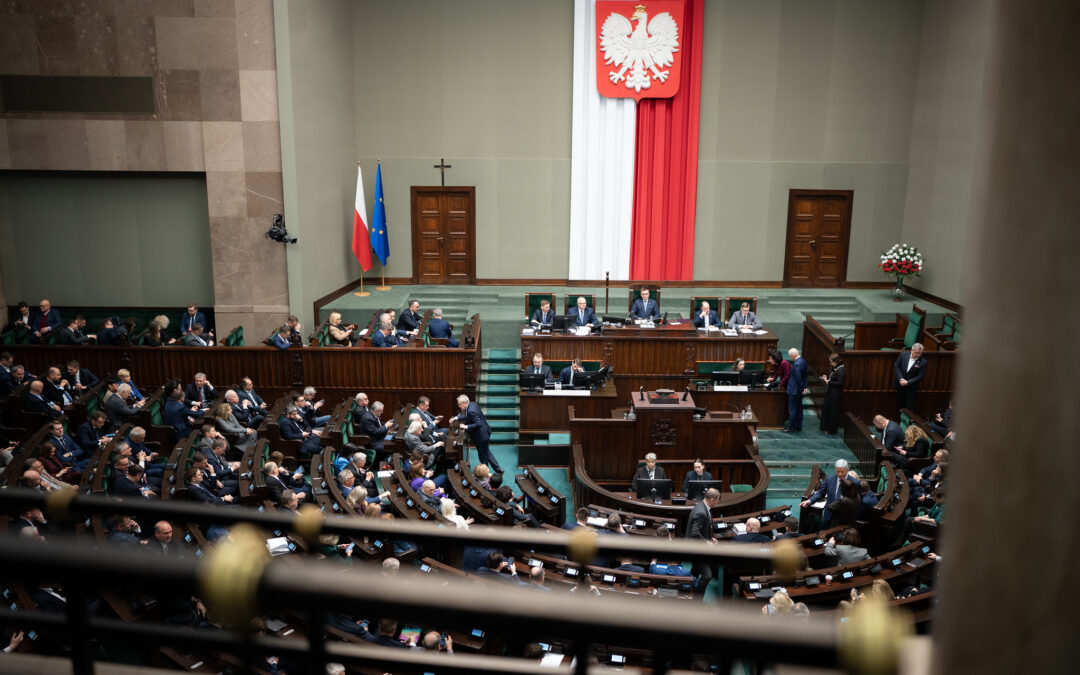By Karolina Baca-Pogorzelska (tekst dostępny również w języku polskim)
Ahead of tomorrow’s 34th anniversary of the Chernobyl disaster recent, a wave of widely shared messages about a radioactive cloud gathering over Poland and an accident at the Świerk nuclear reactor have been shown to be fake news. Climate minister Michał Kurtyka was quick to issue denials and reassurances. Yet such misinformation sows panic and demonstrates how raw a subject nuclear energy continues to be in Poland at a time when debate over future energy choices is vital.
Pripyat, a ghost town in the Kyiv province in northern Ukraine. It was here, in 1986, that tragedy struck after an accident in one of the reactors of the nuclear power station. The success of last year’s HBO series Chernobyl brought crowds of tourists to the exclusion zone. The local guides were left scratching their heads at the renewed popularity of a place that the world had almost forgotten.
Today it is back again, at least in Poland, albeit in a slightly different context. As a result of the drought that is beginning to devastate the region, since the beginning of April Ukraine’s emergency services have been fighting major fires. At Easter, the flames reached the Red Forest, adjacent to the reactor at Chernobyl, recently covered in its latest enormous sarcophagus.
Fake news on Chernobyl
The fires themselves are an enormous tragedy, but the communications resulting from them are also worrying. Many Poles received text messages or emails with a warning from “an aunt at the health department” or “an uncle from the border patrol” to avoid going outside on the weekend of 18-19 April because a radioactive cloud was approaching from Chernobyl. Others said that there had been an accident at Poland’s only reactor, the Maria research facility in Świerk near Warsaw.
#FakeNews jest rozpowszechniany by siać strach i zament. @wirtualnapolska dementuje. Radioaktywna chmura nad Polską po pożarze w Czarnobylu? Nie dajcie się oszukać- WP Tech https://t.co/rXukkJ1Ce1
— Marek Zadęcki (@MarekZadecki) April 18, 2020
The intensification of this false information ahead of the anniversary of the disaster and a heightened level of fear during the coronavirus pandemic has evoked unnecessary emotions. And not for the first time. Around 15 years ago, I was working at the Rzeczpospolita newspaper when a similar “nuclear rumour” forced me to visit Świerk to check out the reports.
The difference was that social media at the time were not such a key means of communication as they are today. At a time of isolation and emotions brought on by the pandemic, it is much easier than usual to whip up fear. And it is especially important to counteract false reports.
First of all, there was no increased radiation caused by the fires in the exclusion zone. Second, simply by checking the wind direction one could see that the rumours were incorrect. Despite this, Polish YouTube videos spreading the false information on the supposed cloud have been watched 236,000 times.
Radioaktywna chmura znad Czarnobyla nad Polską to fake newshttps://t.co/hmG0UdzWVr
— Karolina Zbytniewska (@KarolinaZby) April 19, 2020
Poland’s nuclear debate
What makes this issue even more concerning and pressing is that Poland is on the eve of a crucial decision over whether a nuclear power station will be built. It is therefore all the more important to observe how false information can shape people’s moods.
“Disinformation associated with radiological threats can definitely have an effect on how society perceives nuclear energy,” Patrycja Rapacka, a journalist at the Biznesalert.pl website who has collated the recent fake news stories, tells us.
“If emotions come into it, we won’t be able to take a rational perspective on evaluating the legitimacy of investing in nuclear power in Poland,” she continues. “The recent fake news circulating in social media concerning a serious radiological threat will only fuel the aversion to nuclear power in the energy mix.”
Work is currently taking place on the government’s “Energy Policy of Poland until 2040” (EPP2040) document, which foresees that within two decades around 10% of the country’s electrical energy production will come from nuclear.
This is a crucial decision from the perspectives of energy security, environmental concerns (at present more than 70% of electricity in Poland is still produced from coal) and economics, because the cost of building reactors of the expected power of 6–9 GW is forecast at well over 100 billion zloty.
“EPP2040 is still under consultation, so it is worth considering who it is playing on our emotions,” says Rapacka. “The authorities, such as the ABW [Poland’s counter-intelligence agency] should look into the source of the spread of this kind of information…about radioactive contamination.”
Jakub Wiech, deputy editor of Energetyka24.com, a news service dedicate to energy issues, tells us that:
In Poland, support for constructing nuclear power stations is quite high. According to research conducted by the Ministry of Energy in 2017, 59% of Poles were in favour of building one. The fake news we have observed recently about nuclear energy…is unlikely to change this support diametrically, especially as the industry media and experts are quick to deny it. Still, the mechanism of their emergence is striking, because the messages spread fast through the grapevine.
A poll carried out by IPSOS for OKO.press last year, which asked respondents to choose two main energy sources that Poland should invest in, found that 81% of Poles picked renewables while 31% went for gas, 30% for nuclear and only 20% for coal. Women, however, preferred coal to nuclear: just 19% chose the nuclear option, as opposed to 43% of men.
Anti-nuclear protests
According to Wiech, the latest nuclear rumours raise justified questions over information security in Poland. If similar reports emerge when the location for the nuclear power station is being selected or constructed, they could lead to local protests.
“In normal conditions, this kind of nuclear disinformation could be treated as a reason to launch a campaign providing reliable information in nuclear technology, he says. “Now, though, at the time of the coronavirus pandemic, it seems unlikely to capture people’s attention. But I don’t think that acceptance for the plan to build a nuclear power station is under threat.”
Nuclear energy in Poland is a little like the Yeti. Everybody has heard of it, but nobody has seen it. During the Civic Platform-led government of 2007-15, a special purpose entity, PGE EJ, was set up to sound out potential locations (none has yet been chosen).
Even then, the anti-nuclear protests of residents at one of the three potential sites, Gąski in Mielno county, on the Baltic coast, were successful in having it removed from the list. Locals chanted an adapted version of a children’s rhyme playing on the meaning of their village’s name, warning the “goslings” (gąski) of the perils of the big bad nuclear wolf.
In a local referendum, some 95% said no to a power station. In 2012, a chapel was erected in Gąski with a statue of the Virgin Mary saying “Protect us from nuclear power” (another play on words, as broń means both “protect” and (nuclear) “weapon”).
The remaining options, Żarnowiec (the same location where in the 1980s Poland began and then suspended building its first planned nuclear power station) and Choczewo, are still being considered as possible sites for a power plant, assuming an official decision on such an investment is made.
Nuclear neighbours
The fear of atomic power in Poland makes little rational sense. After all, for years we have been surrounded from all sides by working reactors. And the fact that Poland is a blank spot on the nuclear map does not mean that, if things “went wrong” for any of our neighbours, we would be immune to the consequences.
The decisions of Poland’s neighbours are important in this context. Germany is abandoning nuclear power. This decision was taken after the Fukushima disaster in Japan, although there are still a few working blocks. Reactors also remain active in power stations on Poland’s southern border – in Slovakia (Mochovce) and Czechia (Dukovany, Temelín). There are four sites in Ukraine – including in Khmelnytskyi, close to the border.
Construction of a Russian power station in the Kaliningrad oblast has been suspended, while Lithuania has switched off its plant in Ignalina – which, incidentally, was constructed identically to the Chernobyl blocks in technological terms. Lithuania has also decided not to continue construction of its new power plant in Visaginas.
In Belarus, however, construction of a new nuclear power plant in Astravets is now being finalised. I had a chance to see the development for myself in late 2017. There are several reasons why it is very interesting.
First, it is being built by the Russian company Rosatom with money lent by Russia to Belarus. Second, Belarus does not actually need this power plant, because it will only generate surplus electricity (Poland has announced it will not be buying it). Third, the installation is being built close to the Lithuanian border, in a place which 30 years ago was one of the last Belarusian nuclear power station sites, 50 km from Vilnius, the Lithuanian capital.
The reactor will be cooled by water from the River Vilya, and any potential contamination will mean that Vilnius would have radioactive water within two hours. And this is not fake news, because during construction serious accidents were covered up, and in the case of this power station we can expect information on any problems to be delayed, as was the case with Chernobyl in 1986.
The clock is ticking for Poland
This is why it was so important that climate minister Michał Kurtyka was quick to deny the fake news spread about Chernobyl this time. He also noted that radiation levels can be checked at any time on the website of the National Atomic Energy Agency, which also issues relevant statements on this matter.
We are still waiting for the Polish decision on nuclear energy, although the clock is ticking. Bearing in mind the fact that in accordance with EU law Poland will gradually be shutting down the oldest coal power plants as they fail to conform to norms, its needs to decide what to replace them with.
Importing energy is possible, of course, and still growing in Poland. For the country’s energy security, however, it is important to decide what will replace coal in future. Will it be nuclear energy, which Germany and Japan are leaving behind but Hungary is developing, or perhaps more renewable energy sources, such as the planned offshore wind farms on the Baltic? The Polish government’s decision is due within the next few months.
Translation: Ben Koschalka





















